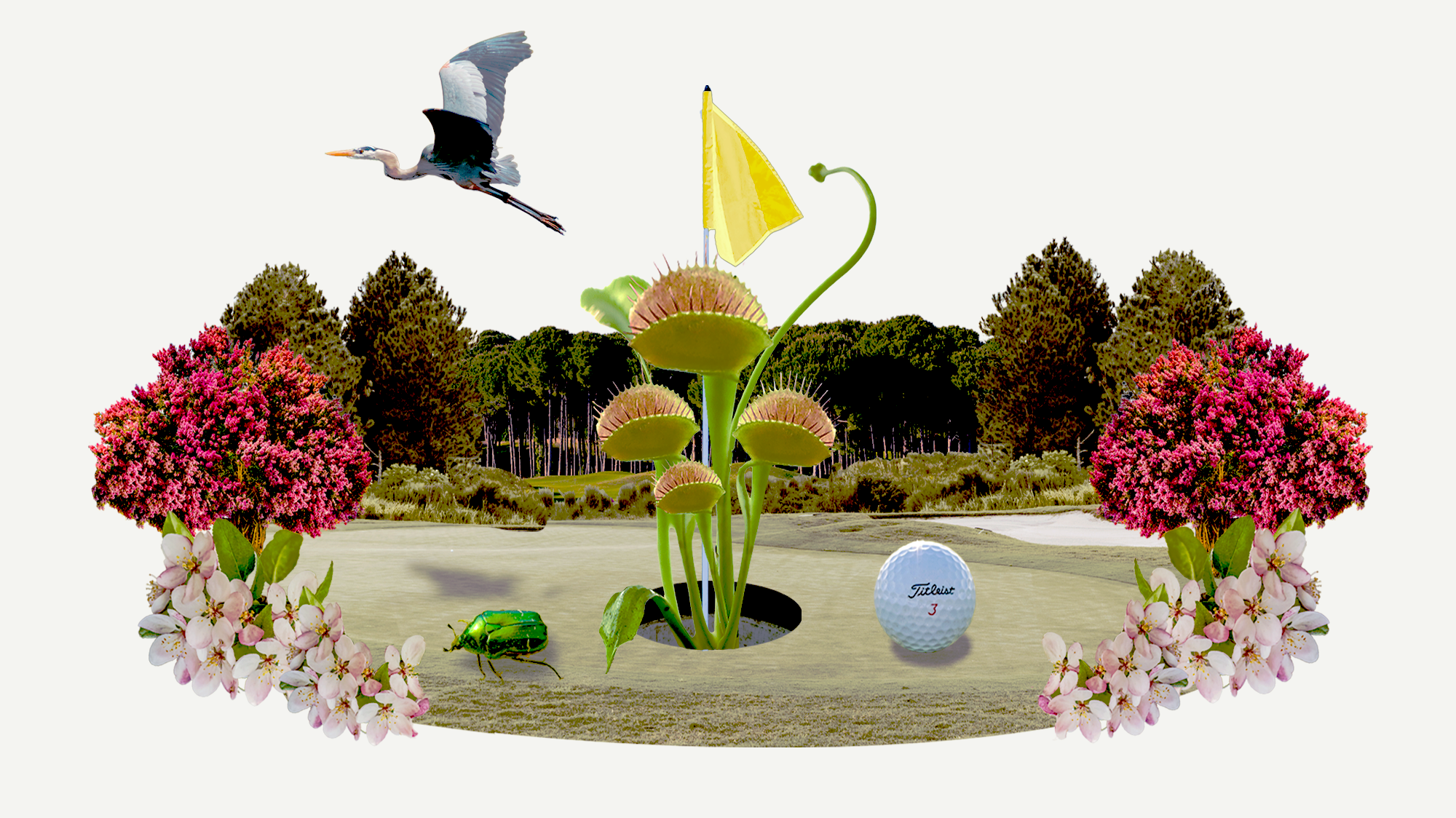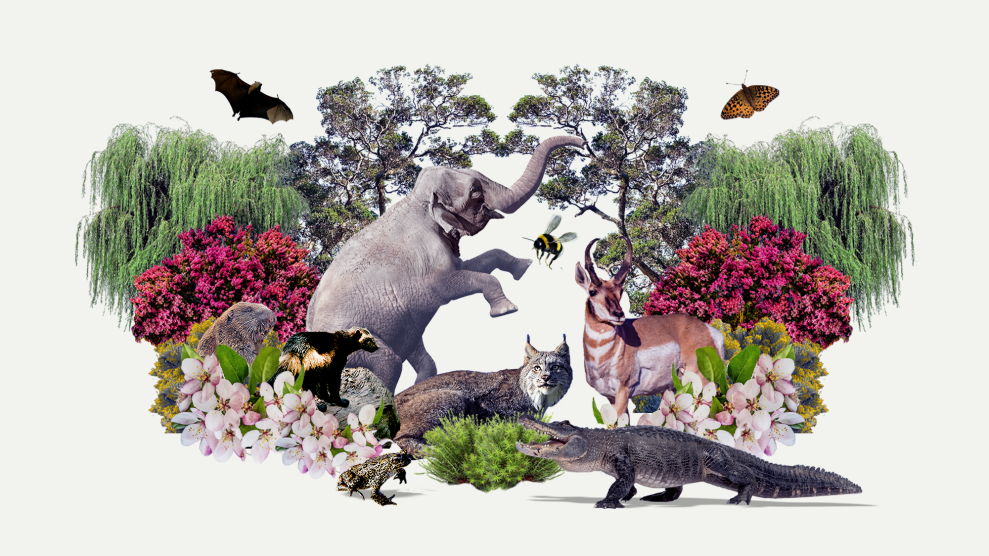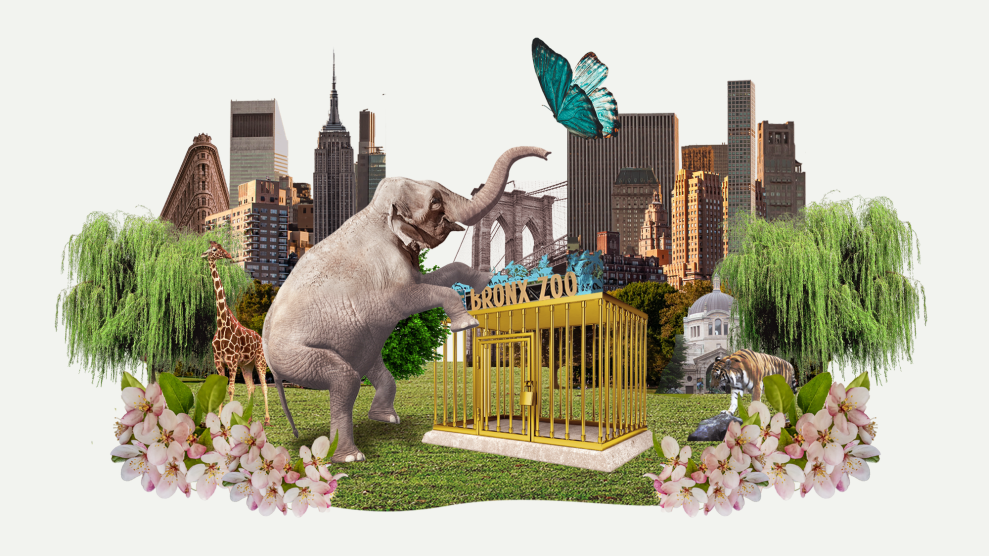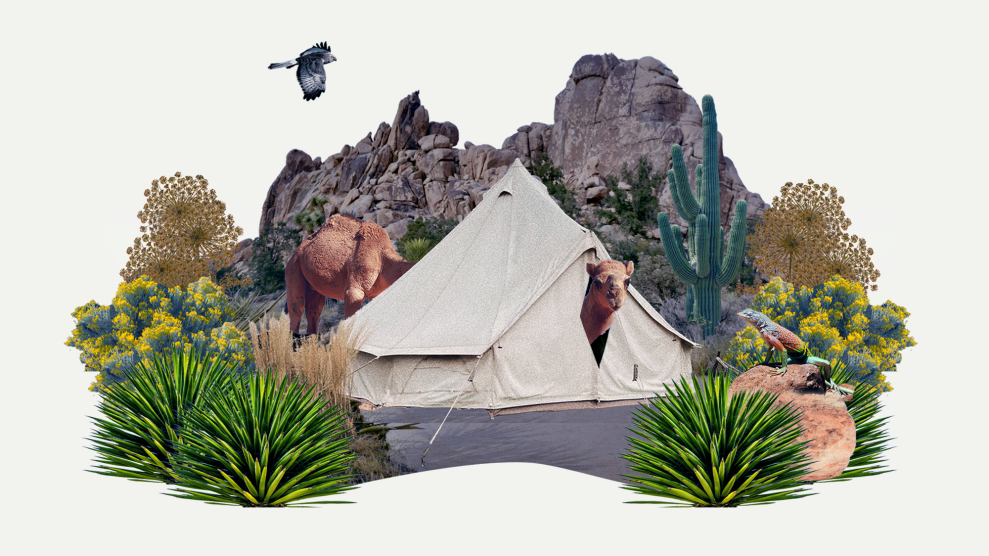The Endangered Species Act has been one of the country’s most valuable environmental tools, but it faces new threats. As the law turns 50, we’re asking whether this “pit bull” of an environmental law, as one expert described it, can survive the challenges of our time—from political attacks to climate shocks. You can read all the stories here.
There’s something unsettling about the Venus flytrap. When it eats, it behaves more like an animal than a plant, ensnaring unsuspecting insects in its fragrant snap trap in as little as a third of a second. And while one can understand, rationally, that the Venus flytrap evolved its taste for bugs over tens of millions of years as a means to source more nutrients, watching it move feels suspiciously otherworldly, alien. It hunts.
“There’s nothing else in the world like it,” retired Fish and Wildlife Service biologist and flytrap maven Julie Moore told me. “Noth-ing,” she said, emphasizing each syllable. To her, the plant’s quirky modifications—its diet, jawlike leaves, and speed—aren’t scary; they’re evidence of Mother Nature’s power to survive, and what put Moore on a path to protect it.
While you can buy the hairy carnivorous plant at garden centers, and even Walmart, Venus flytraps only grow in the wild in one place on Earth: the wet longleaf pine forests of the Carolinas, boggy areas where scientists estimate about 880,000 individual plants remain in just 74 colonies. A few years ago, Moore, who now runs a flytrap conservation nonprofit, got her hands on a confidential report commissioned by her old agency revealing some of the plant’s last remaining wild clusters.
One of them was in St. James Plantation, a retirement community in Southport, North Carolina. This was a gated community, an apologetic real estate agent told us when we arrived at the property’s front office in October: Unless we were there for “real estate purposes,” he said, we weren’t allowed in. Moore, 76, wearing khakis, a long-sleeve periwinkle T-shirt with a luna moth on it, and socks that read “CRAZY PLANT LADY,” explained that we were on the hunt for flytraps. “They’re disappearing fast, and we want to keep them,” she told the agent in her Texas accent, adding that this county, Brunswick, has more wild flytraps than anywhere else in the world. It is also among the top 10 fastest-growing counties in the country.
After a bit of friendly chitchat about Moore’s work, the real estate agent relented (“people like old ladies,” Moore had told me), and handed her a map of the property and a gate pass. “All I ask is that you guys buy a house from me in the future,” he said, only half-joking.
St. James wasn’t some humble neighborhood. It was, legitimately, a town. With more than 4,000 properties across 6,000 acres, the “plantation” (an interesting marketing choice) claims to be the top-selling community of any kind in the Coastal Carolinas. For an estimated $669,000 on average, St. James’ large homes come with access to a chapel, walking trails, pickleball courts, a dog park, and 81 holes of golf. On our map, the streets squiggled across the page like a pile of spaghetti, a morass of idyllic suburbanhood. Somewhere between those folds, according to Moore’s confidential report, there were at least three Venus flytrap populations. Or so we hoped.
We hopped into her red Mercedes-Benz and drove slowly to the 10th hole of a golf course, where three years ago biologists reported more than 250 individual plants. All I could see was sod, a small drainage ditch, and a sign that warned “CAUTION CART CROSSING.” Developers had left patches of longleaf pine groves along the edges of the course, but most of the trees and other native plants had been lost to the perfectly manicured green.
“I don’t think it’s going to do us much good to get out and walk around and look for flytraps,” she said, sounding more pragmatic than disappointed. “This habitat is totally fucked up.”
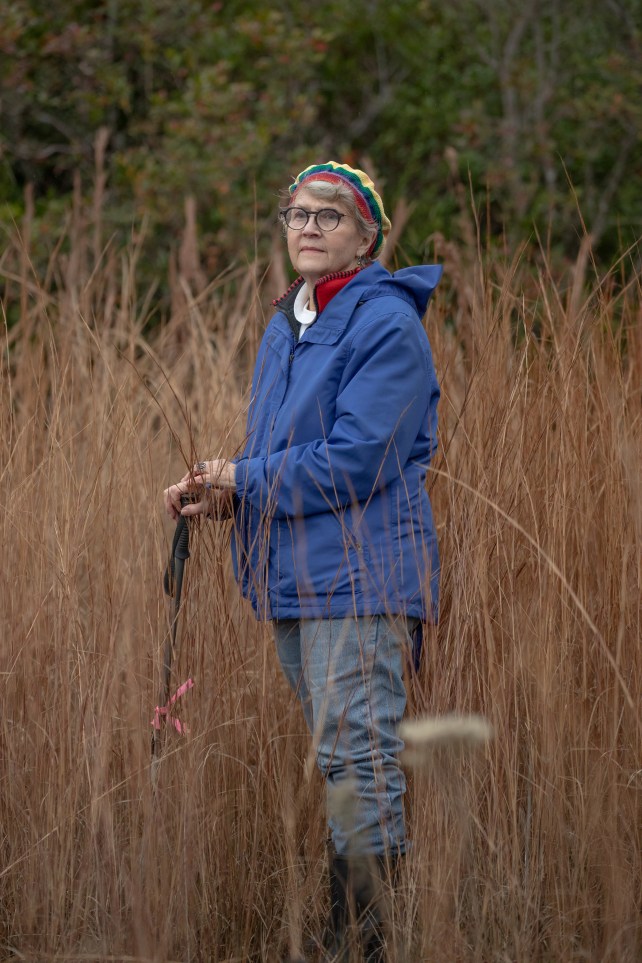
Julie Moore, a former Fish and Wildlife Service biologist, has devoted her retirement to flytrap conservation.
Madeline Gray
The Venus flytrap is a survivor. It emerged about 65 million years ago, just after the extinction of the dinosaurs, with an evolutionary hack: a jawlike snap trap that allows the plant to thrive in poor-quality soils by attracting insects with fruity-smelling compounds emitted from its leaves. Although pop culture has depicted flytraps as monstrous, blood-hungry beasts (remember the 1986 horror comedy classic Little Shop of Horrors?), the plants don’t actually drink human blood or attack people. Adult Venus flytraps, which get their name from the Roman goddess of love, typically sit just a few inches off the ground (but shoot up flowers about a foot high in the spring), and their snap traps are not much bigger than a quarter. For millennia, they relied on wildfires that regularly swept through the forest, clearing brush that would otherwise block out the sun these tiny plants need. But due to a toxic combination of land development, fire suppression, climate change, and poaching, the flytrap has seen at least 66 of its 140 known colonies disappear. Of the remaining plants, two-thirds live in just three large clusters in Brunswick County.
In 2016, a group of scientists led by Don Waller, then a botany professor at the University of Wisconsin, Madison, petitioned the Fish and Wildlife Service to protect the Venus flytrap using one of the country’s most powerful environmental tools: the Endangered Species Act. This past July, after nearly seven years of waiting, the agency rejected their application, concluding that the plant was not in immediate danger of extinction. Moore fiercely disagrees with the ruling, arguing that the agency’s analysis was incomplete and “sophomoric.” In an August op-ed in the North Carolina nonprofit news site Coastal Review, Moore and Waller wrote that the government “underestimated the risks Venus flytraps face from climate change,” especially sea level rise and drought.
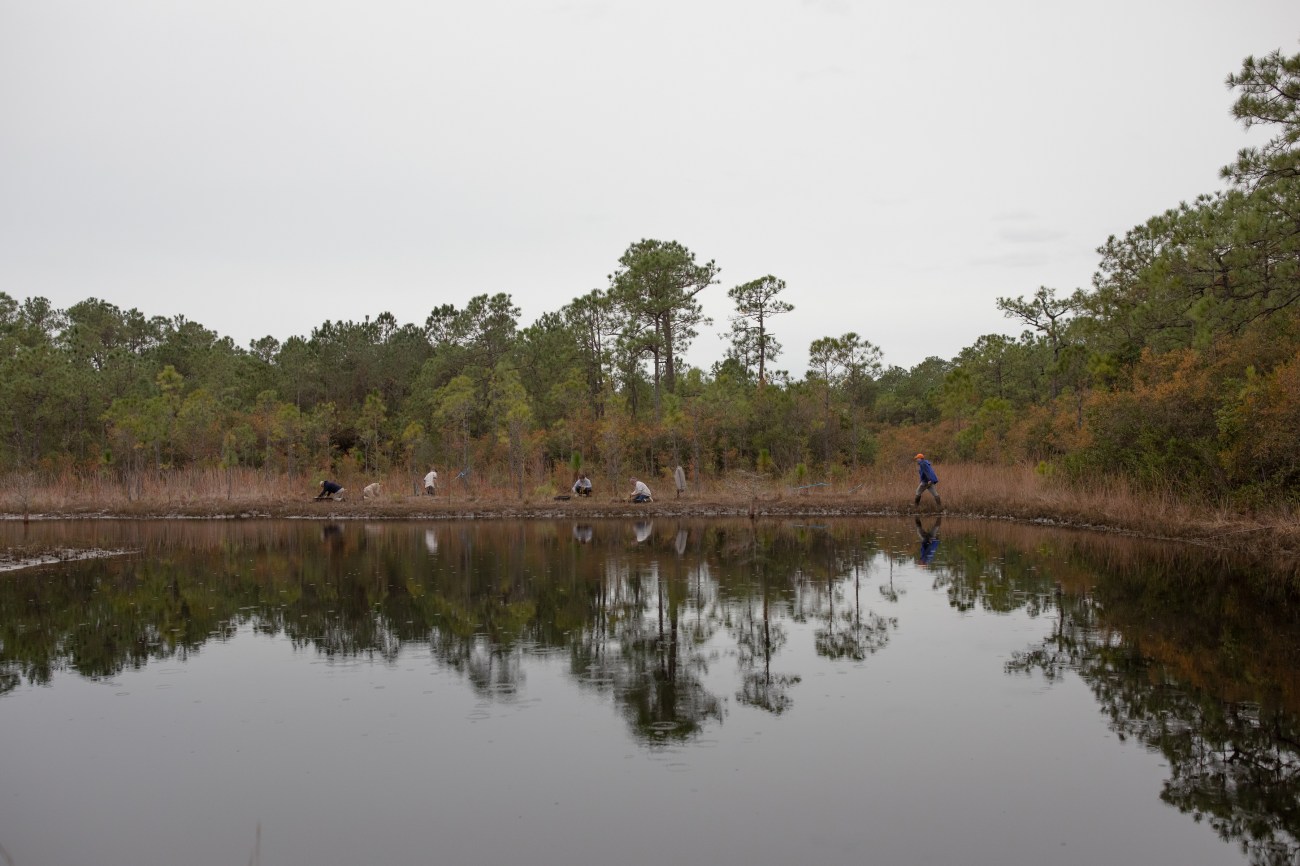
Volunteers replant Venus flytrap plants in a safe habitat after rescuing them from the side of the road in Boiling Spring Lakes, North Carolina.
Madeline Gray
The Biden administration also failed to consider the pace of development in the Carolinas, Moore and Waller argued, especially given the boost handed to developers by the Supreme Court in May, when it ruled against the Environmental Protection Agency and declared that wetlands without a “continuous surface connection” to a body of water are not subject to regulation under the Clean Water Act. The ruling effectively cut the number of protected wetlands in the country by half—opening millions of acres to unmitigated building, including an estimated 2.5 million acres in North Carolina, or about 7 percent of the state’s total area. The miry groves where the flytraps live are especially hard hit. “It’s the worst thing that’s happened in my conservation life,” Moore told me.
Now the plants are stuck in a kind of limbo—their populations aren’t doing well, but not bad enough to require federal action. Their predicament underscores what some scientists and legislators argue is a key flaw in the Endangered Species Act: While it’s considered an “emergency room” for endangered plants and animals—a last-resort law to protect species on the brink of extinction—it does very little to prevent them from landing in that emergency room. “The worst thing about the act,” Moore says, “is it’s waiting for things to get to the point where you’re in trouble.”
Luckily for the flytraps, Moore is particularly well-positioned to take up their cause. “I’m not a hobbyist,” she noted on one of our first phone calls. “I’m a professional.” Though her parents are from Texas, Moore grew up on the water in Hampton, Virginia, and became interested in flytraps as a graduate student at UNC, Chapel Hill, while collecting plants for the university’s herbarium, a library for dried plant specimens. “To me, it’s the speed,” she said about the carnivorous plants. “It’s just amazing.”
After a stint at the North Carolina Heritage Program, the state’s primary biodiversity agency, she landed at the Fish and Wildlife Service in DC in 2004. There, she focused on convincing private landowners to voluntarily take up conservation measures for all types of threatened critters, including longleaf pine species like the red-cockaded woodpecker. When she retired in 2019, she left feeling like the agency failed to understand and serve people on a local level. So, after settling down in Raleigh, she founded Venus Flytrap Champions, knowing full well that public support of a key charismatic species can help save whole ecosystems. Now she treks up and down the coast, trying to convince people to safeguard flytraps and, in some cases, digging them up to relocate them. Think of her as Susan Orlean’s orchid thief but for rescuing, not stealing, plants.
Moore tells me she doesn’t consider herself a “nice” person—she just has things she “wants to get done”—and her hobbies, she admits, are mostly “plant-centric.” Even her romantic relationships have often had a plant connection. The “least favorite” of her two ex-husbands, a biologist, accidentally discovered flytraps on Fort Liberty military base in the 1980s while studying red-cockaded woodpeckers, and her “favorite” husband worked at the North Carolina Botanical Gardens for decades. Moore’s dislikes include panda bear encounters, cave diving, and marriage—“I don’t like all that cooperation stuff,” she told me on the two-hour drive from the airport in Raleigh to what Moore insisted be the first stop of my trip, a wet longleaf pine forest.
If you’ve been to the South, you’ve likely seen a longleaf pine. Soaring up to 110 feet tall and straight as nails, with puffs of needles at its tips, the trees once spanned up to 90 million acres from eastern Texas into Virginia. Today, about 5 million acres remain—yet they host some of the most ecologically diverse areas in the United States.
“This is optimal habitat for flytraps,” Moore told me as we trudged through the forest. We visited just before sundown, the towering longleaf pines slicing the light into golden strips. In 1984, researchers documented as many as 42 species of plants in about 2.5 square feet on this spongy forest floor. On our walk, Moore pointed out a few of the regulars—wiregrass, St. John’s wort, sphagnum moss, wax myrtle, red bay, liatris, fly poison, cinnamon fern, sweetbay magnolia—and lots of Venus flytraps. In an area about the size of a basketball court, there were hundreds—so many I worried I’d step on them.
At one point, Moore directed me to squat down to look at one. Four or five lime-green, spiked mouths shot up at me from the ground, some with a tinge of red in the center. When tiny “trigger hairs” on the inside of its leaves are touched more than once, she explained, it causes the snap trap to shut. I clumsily ran my finger down its center, and after maybe a second, its lobes folded together almost as fast as a blinking eye. I was both delighted and disturbed.
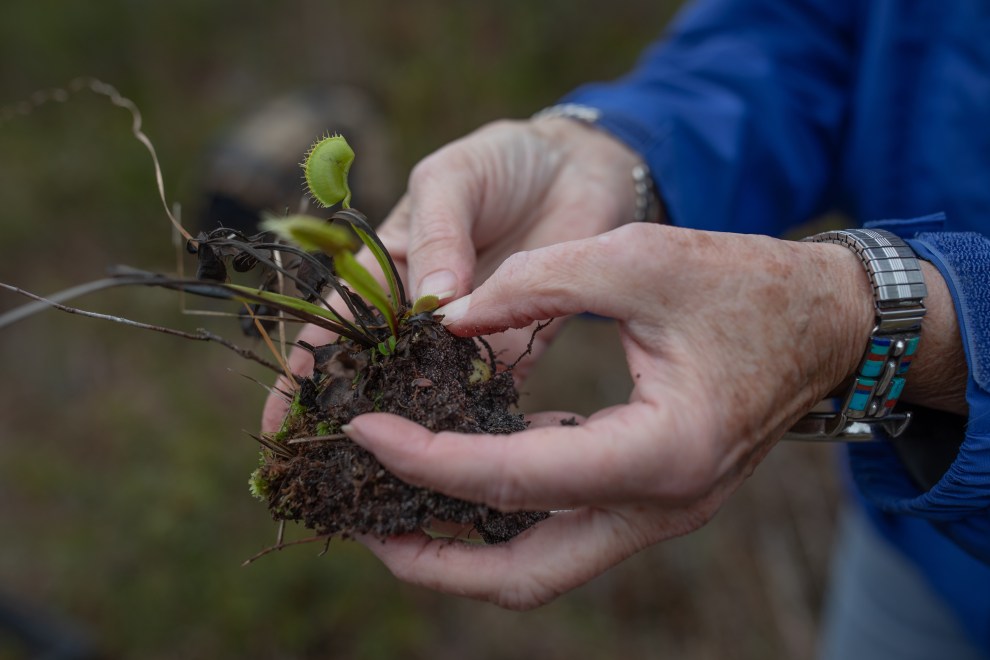
The Venus flytrap emerged about 65 million years ago with an evolutionary hack: a jawlike snap trap that allows the plant to thrive in poor-quality soils by attracting insects.
Madeline Gray
The speed of flytraps fascinated Charles Darwin, who called them “one of the most wonderful plants in the world,” and promised to “stick up for” it “to the day of [his] death.” More than a century later, it was Darwin’s writings that inspired Waller to formally petition the Fish and Wildlife Service; without ESA protection, he told me ahead of the agency’s ruling, he could imagine that we’d begin to see wild populations “winking out of existence” in the next 10 to 20 years.
The act, which turns 50 this month, currently protects more than 1,500 plants and animals and has prevented extinction for 99 percent of all listed species, including the bald eagle and grizzly bear. When it was signed by Richard Nixon in 1973, the country was in a period of environmental reckoning. Rachel Carson’s Silent Spring had exposed the deadly harms of pesticides on wildlife; lakes and rivers were so polluted that one actually caught fire; and the rapid declines of a variety of “charismatic megafauna,” including alligators, jaguars, and California condors were all over the news. Nixon framed the preservation of these species as an American, almost religious, value. “Nothing is more priceless and more worthy of preservation,” he said, “than the rich array of animal life with which our country has been blessed.”
But in five decades since it passed in a bipartisan landslide, the law has become increasingly politicized, with one ESA historian estimating it’s sparked more lawsuits than any other piece of federal legislation. It’s been brandished by both Democrats and Republicans to block the development projects they oppose, be it the border wall and fossil fuel pipelines or affordable housing and renewable energy. In many cases, however, the law simply protects against the “take”—killing, hunting, harming, collecting—of listed species and provides a checkpoint to ensure that building projects are executed with biodiversity in mind.
As FWS deliberated on whether to admit the flytrap into its “emergency room,” the situation for the feisty plant got even worse. In early 2023, the Supreme Court ruled in favor of the Sacketts, a couple who wanted to fill in wetlands to build a home in Idaho. The EPA, citing the Clean Water Act, had threatened to fine the Sacketts $40,000 per day. With the help of the Pacific Legal Foundation, an anti-regulatory group backed by conservative organizations like the Koch brothers and the Bradley Foundation, the Sacketts sued, eventually bringing their case to the country’s highest court. The court not only sided with the Sacketts but also rewrote the definition of “waters of the United States” to exclude millions of acres of wetlands. “This decision might as well have been written in the 19th century,” Harvard environmental law professor Andy Mergen told me. “You just feel like they’re denying the science, at a really profoundly critical time in our history.”
Before Sackett, Moore tells me, if a town in Brunswick County wanted to put in a road through wet longleaf pine forest, for instance, they might have to write an environmental impact report, or even set aside some areas of the boggy forest for protection. Now, no such federal safeguards exist.
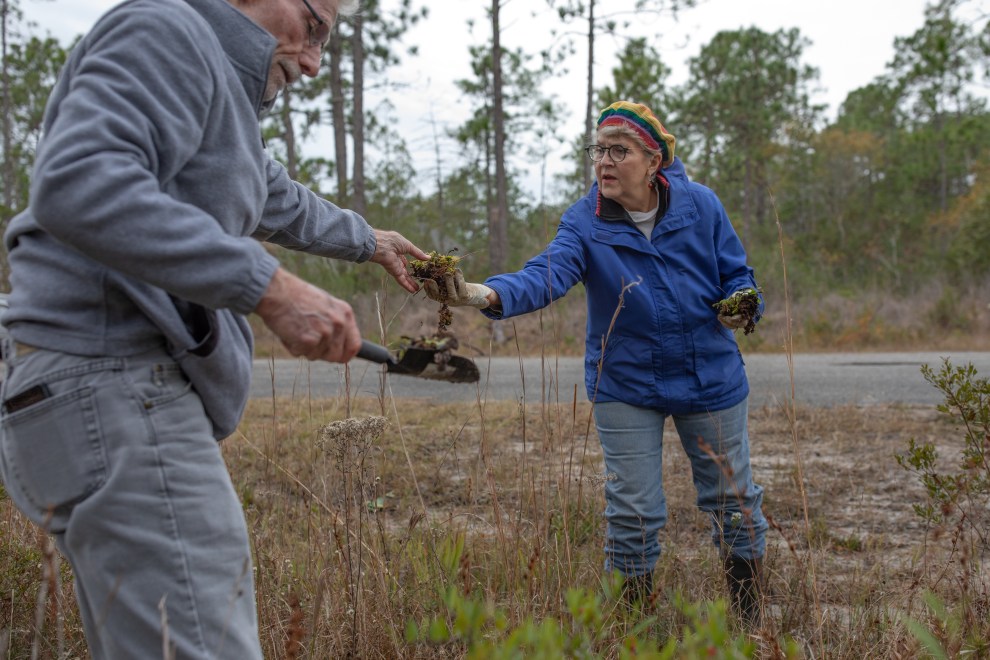
Moore takes a Venus flytrap plant from a volunteer as they rescue flytraps from the side of the road to be relocated to a safe habitat in Boiling Spring Lakes.
Madeline Gray
Back on our quest, Moore told me she had a lead on a residential property, less than half an acre in size, that was home to possibly thousands of flytraps.
It sat at the end of a modest driveway in the town of Boiling Spring Lakes, among a thicket of longleaf pine trees and on a former lake that had been drained after a 2018 hurricane burst the town’s dams. “Okay, let me just think about it, how I want to do this,” she mulled as we drove by, adding that knocking on people’s doors is usually unsuccessful. She decided to park and call first instead. We found the owner’s name, Terry Dail, in the report, and a phone number. But it’d been disconnected. We’d have to knock.
A twentysomething young man opened the door. His grandfather, 75-year-old Terry Dail, was not far behind. Moore explained her mission. Far from seeming inconvenienced by our uninvited appearance, Dail eagerly told us at least 1,500 flytraps were growing in his backyard, along with 600 pitcher plants, a family of related carnivorous plants, some of which are endangered. “I have so many back there,” he said, “I don’t know where there’s that many anywhere else.” After lacing up his Hoka sneakers and popping in his dentures, he agreed to take us there. Moore flashed me an “okay” sign with a grin—we were in.
His backyard was a paradise, not just for flytraps but for all sorts of creatures—grasses, native terrestrial orchids, vanilla root, woodpeckers, and chiggers (a type of biting mites, I learned the hard way). Dail’s grandson Andrew joined us in the backyard, and the two of them pointed out dozens, if not hundreds, of flytraps. “I don’t want anything to happen to ’em,” Dail said, assuring us that he only mows his backyard late in the year after the flytraps have a chance to flower and seed. This was music to Moore’s ears. The mowing, if done at the right time, duplicates natural burning. Dail, as it turned out, didn’t need much coaching.
After about an hour of chatting about fox squirrels, pig pickin’ cake (a local delicacy), and the flytrap’s ESA listing decision (Dail’s grandson had written a paper about it for class), Dail walked us back to the car, where Moore presented him with a white, round, metal-and-plastic pin that read “Venus Flytrap Champions,” alongside a cartoon of a flowering flytrap.
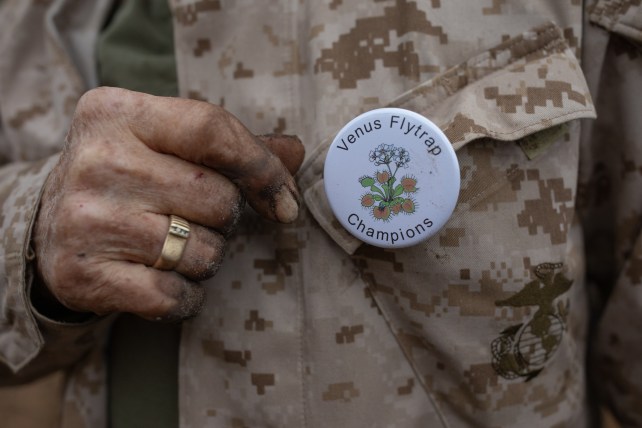
A volunteer wears a button given out by Moore’s flytrap conservation nonprofit.
Madeline Gray
But small landowners like Dail can do only so much. Across the former lake from his house, a new subdivision called the Highlands had just opened. Out front, signs advertised “homes from the upper $200s” and “BEST VALUE IN THE REGION.” We drove past dozens of nearly identical vinyl-sided houses to the one last road that was still flanked by longleaf pines. Throughout the neighborhood, fluorescent tape marked some of the trees, indicating they’d be cut.
About seven weeks earlier, Moore and a team of volunteers had relocated more than 1,000 flytraps growing here to a nearby nature preserve. One of the volunteers joined us to look for any stragglers they might have missed. As we searched, a middle-aged woman wearing a bright red windbreaker and walking a silky Belgian Malinois approached. She introduced herself as Ivy Weaver and told us she’d lived in the area for seven years and watched how it had transformed from a wooded enclave to a barren housing development. “We are not happy,” she said; “they’ve chopped down all the trees. The wind has changed. The next storm that comes through—we’re all in for it.”
She had a point: Longleaf pine forests, where flytraps thrive, aren’t just pretty. They buffer high winds, reduce the impact of floods, fight erosion, and sequester carbon. Weaver, who used to build homes for a living, told us these new houses were built on concrete slabs atop soggy ground. The next time hurricane season rolled around, she predicted, “We’re all going to have heavy flooding…It’s greed over need.” (The development company behind the Highlands property, Logan Homes, did not respond to a request for comment. When I asked the town about Weaver’s concerns, a spokesperson told me via email that the builders “have all the necessary permits to construct these homes.”)
The Highlands subdivision, of course, is not single-handedly responsible for the flytrap’s fate. It’s the web of new developments—strip malls, road expansion projects, storage facilities, and more—popping up everywhere in the coastal Carolinas that threaten the survival of the plant. A new bill, however, could help. The bipartisan Recovering America’s Wildlife Act, which passed the House 231–190 in June 2022 and was introduced in the Senate for the second time in March 2023, aims to protect vulnerable species before they require the ESA “emergency room.” It would supply nearly $1.4 billion per year to states and tribes to support their own conservation plans, from planting milkweed for monarch butterflies to conducting controlled burns in longleaf pine forests. “It would be the biggest landmark piece of legislation on conservation in a decade,” lead House sponsor Rep. Debbie Dingell (D-Mich.) tells me. For North Carolina, it would mean some $20 million per year “to conserve and restore” nearly 500 species of concern and their habitat—20 times the amount the state currently receives in federal grants. The idea being, sort of like home repairs, invest now to save the headache—and cost—of a future catastrophe. As Moore says, RAWA would make protecting the flytrap “cheaper in the end.”
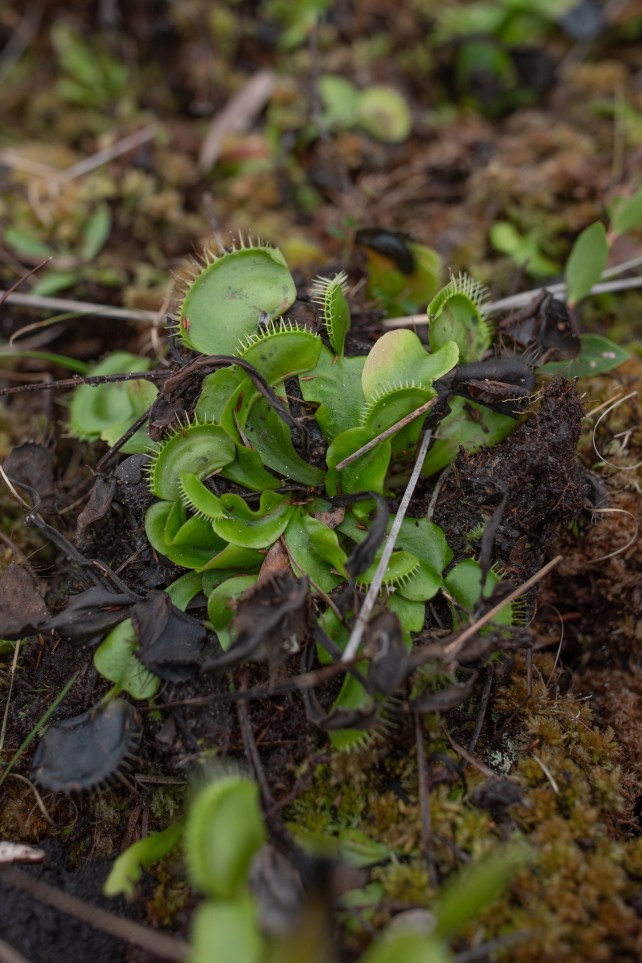
Venus flytraps wait to be relocated from the side of the road.
Madeline Gray
Moore and I never found any wild flytraps at St. James Plantation. But we did find something else. A homeowner named Judy told us that hundreds of flytraps were relocated from her yard in 2020, before her home was built, to a community garden on the far west side of the property.
“We didn’t want to, you know, kill them,” she said. “The builder would have just dug ’em up.”
The garden featured all sorts of plants, including jimson weed, spotted bee balm, American holly, spiderwort, Texas tarragon, elderberry, and milkweed. And, in 13 large buckets buried into the ground, hundreds of flytraps.
“Ooh-ho-hoo, they’re so cute,” Moore said delightedly, as we peered over the buckets. “This is really a nice collection.” For Moore, the garden was something of a relief; though they weren’t in their natural environment, the flytraps were safe, where people could enjoy them.
I was glad the flytraps hadn’t been, as the government calls it, “extirpated.” But there was also something disappointing about seeing them there, like watching a caged animal at a zoo. If the flytrap is destined to be confined to the greenhouses of Walmart and the community gardens of posh retirement communities, is it really surviving?
On my last night in Brunswick County, Moore and I sat on the back porch of our motel, sipping from glasses of Josh red wine. I asked her what would really happen if Venus flytraps were to disappear from the wild. The flytrap is not a keystone species, I said. Unlike sea otters, red-cockaded woodpeckers, and earthworms, for instance, the plants do not provide such important ecological roles that, without them, whole ecosystems could come crashing down. Flytraps, as far as we know, are passengers within the system, not drivers. So why even care?
“We don’t know them,” Moore responded. Which is to say, we don’t yet understand how the flytraps might be contributing to the ecosystem—or even how they might directly benefit humans.
As Lee Talbot, one of the original authors of the ESA, wrote in 1980, “Only a very small percentage of the Earth’s wild plants and animals have been investigated in any way for their possible direct values to Man. Yet new values for such species are being found constantly—sometimes quite by accident.” For instance, he wrote, the hollow hair of polar bears, an endangered species, helped inspire the design of cold-weather clothing and solar energy collectors. Research on the armadillo, another endangered species and the only other animal known to contract leprosy, led to the development of a vaccine against the disease. Carnivorous plants have been used in traditional medicine for hundreds of years to treat wounds, stomach aches, and bunions, but little is known about what beneficial compounds might be hiding within the Venus flytrap’s tissues. At least one species, the Venus flytrap cutworm moth, is thought to feed exclusively on flytraps—and we don’t know much about it, either.
Although it may not be a driver, Moore explained, the vehicle in which the flytrap sits—the wet longleaf pine forest—is carrying many other passengers, including an estimated 900 plants, 100 birds, 36 mammals, and 170 reptiles and amphibians. “With the demise of the flytrap,” Moore said, “we’re gonna lose other things.”
Plus, “everybody likes them,” Moore said. She was right. If a plant can possess such a thing, the Venus flytrap has charisma. And so, in an odd twist of fate, the flytrap’s quirky modifications had given it another advantage: People—Darwin, Waller, Moore, and me—were enamored by them. Like some kind of unnatural selection, the plant’s evolved abilities also gave it a fighting chance in the age of humans.
After a long discussion about the interlocking essence of ecosystems and the limits of human knowledge, we decided to call it a night. It was nearing 10 p.m., we’d finished the wine, my legs were covered in chigger bites, and more flytraps awaited us in the morning.

We don’t yet understand how the flytraps might be contributing to the ecosystem, Moore says—or even how they might directly benefit humans.
Madeline Gray
